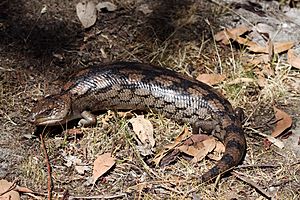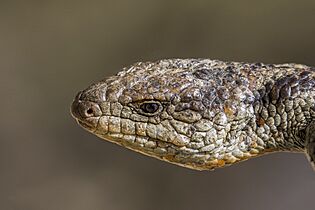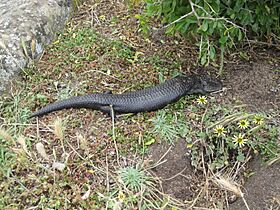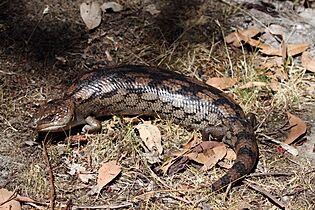Blotched blue-tongued lizard facts for kids
Quick facts for kids Blotched blue-tongued lizard |
|
|---|---|
 |
|
| Conservation status | |
| Scientific classification | |
| Genus: |
Tiliqua
|
| Species: |
nigrolutea
|
The blotched blue-tongued lizard (Tiliqua nigrolutea) is also known as the southern blue-tongued lizard. You might also hear it called the blotched blue-tongued skink. This lizard is a type of blue-tongued skink that is only found in south-eastern Australia.
Contents
Meet the Blotched Blue-Tongued Lizard
This amazing animal has a bright blue tongue! It uses its tongue to "taste" the air around it. This helps it find food and also scares away animals that might want to eat it.
These lizards are quite big and strong. They are part of the skink family. They usually try to hide or pretend to be scary to protect themselves. If they feel trapped or bothered, they put on a really impressive show to scare off danger.
If they are still bothered, they might bite as a last choice. Their bite can hurt because they have strong jaws. But their teeth are usually blunt and don't break the skin. These lizards are harmless and generally calm. Many people even keep them as pets because they are curious and can become quite friendly. They usually do well in captivity and eat many different kinds of food.
What Do They Look Like?
Blotched blue-tongued lizards are about 14 to 20 inches (35 to 50 cm) long. They live in different types of forests and open areas near the coast.
What Do They Eat?
These lizards are omnivores, which means they eat both plants and animals. Their diet includes insects, snails, and even dead animals. They also enjoy wildflowers, native fruits, and certain leaves. Sometimes, if they get the chance, they might eat small animals like mice.
If a predator grabs their tail, they can drop it off. This is called autotomy. It helps them escape, just like many other skinks. However, these large skinks are less likely to drop their tails compared to smaller skink species.
Where Do They Live?
You can find the blotched blue-tongued lizard in several parts of Australia. These include Victoria, Tasmania, South Australia, New South Wales, and the Australian Capital Territory.
Their Home and Habits
Blotched blue-tongued lizards usually come out of their winter rest (called brumation) in early spring. This is when they find a mate. These large skinks give birth to live young, which is pretty cool! Lizards living in cooler, higher areas usually have fewer, but larger, babies (around five). Those in warmer, lower areas tend to have more babies (around 11).
The babies are usually born in autumn after a long time inside their mother. These lizards can also live for a long time. Some have been known to live up to 30 years when cared for by humans! They have learned to live well in some country and city areas. You might find them on farms or in gardens. They are helpful there because they eat pests like snails, slugs, and sometimes even rodents.
Fossils of the blotched blue-tongued lizard have been found in the Naracoorte Caves National Park. This shows they have been around for a very long time!
Who Are Their Predators?
Even though they are good at defending themselves, blotched blue-tongued lizards do have predators. These include:
- Birds of Prey: Large birds like hawks, eagles, and owls.
- Snakes: Bigger snakes, especially venomous ones, might hunt them.
- Mammals: Animals like foxes, feral cats, and dogs can hunt these lizards. This is especially true for younger or smaller ones.
- Monitor Lizards: Larger monitor lizards (also called goannas) can also be a threat.
Gallery







